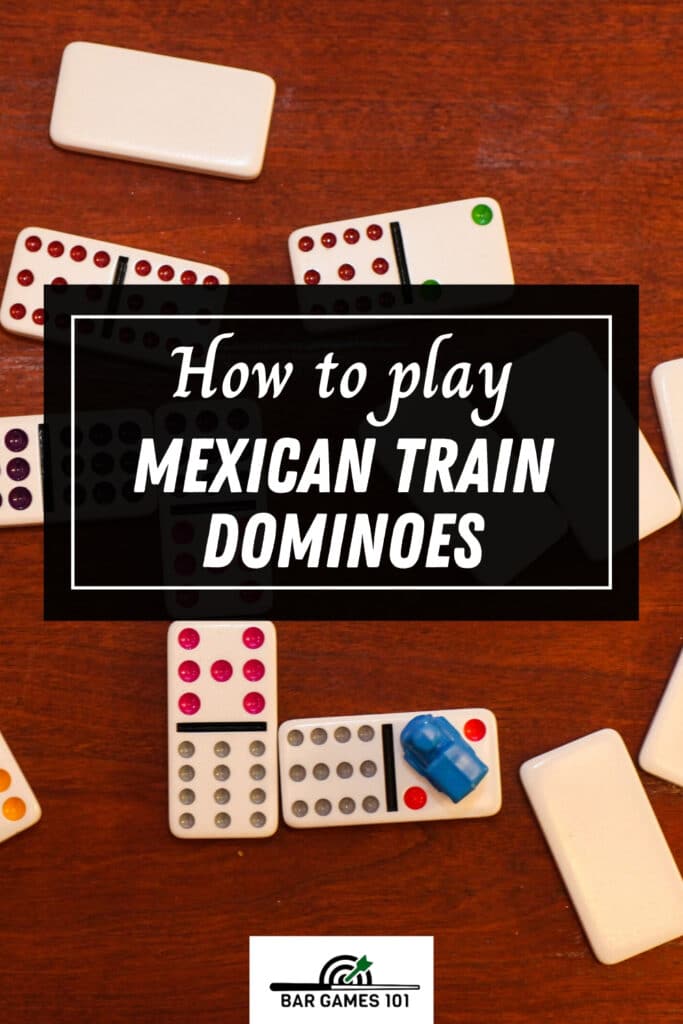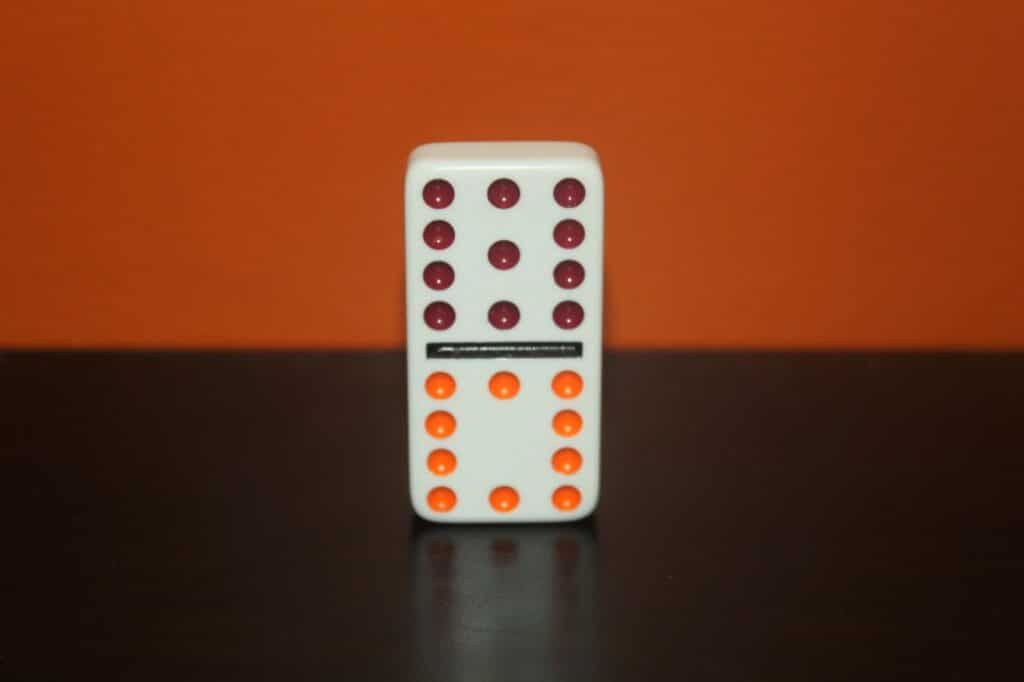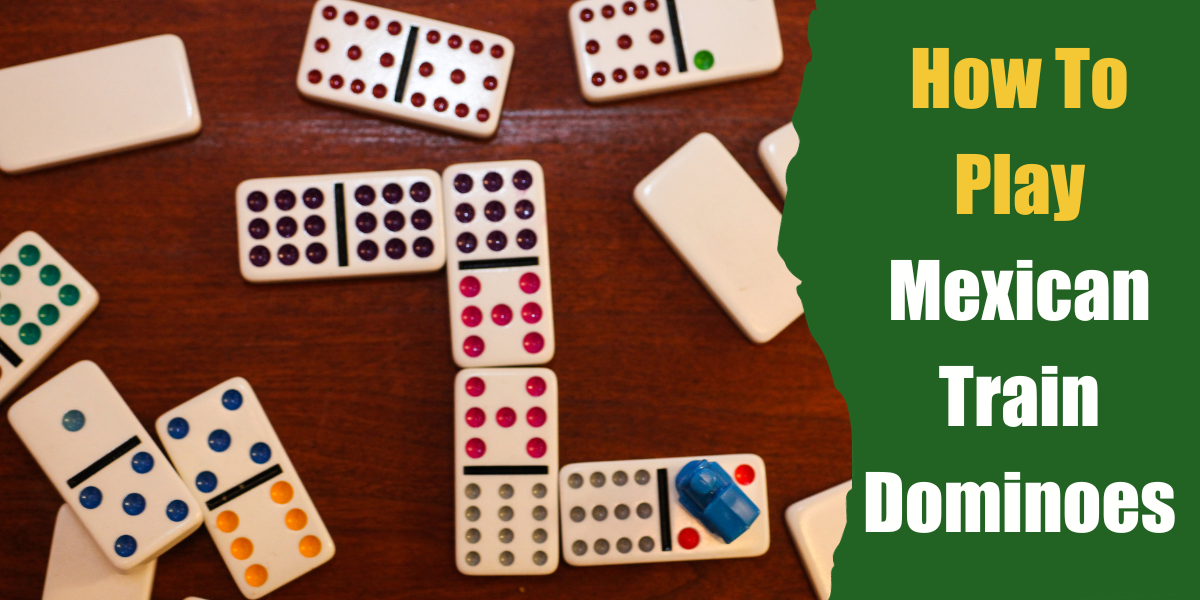Dominoes is considered a classic for good reason. It’s competitive, strategic, and oh so satisfying.
But it’s also notoriously cutthroat, the kind of party game that can quickly turn a quiet family evening into a heated argument.
So what if you want to play a game that’s got the deep strategy of dominoes but with a less in-your-face style of competitive play?
That’s where Mexican Train, a dominoes variant for two to eight players, really shines.
THE BASICS

To play Mexican Train, you’ll need a set of double-12 dominoes, a marker for each player, and a central “train station” hub piece.
The main objective of Mexican Train is to be the first one to play all your dominoes.
If you don’t have double-12 dominoes, variants can be played with other kinds of dominoes as well, depending on how many players you have.
See the “variants” section for more details.
Most dedicated Mexican Train sets come with player markers and hubs, but anything at all can be used as a marker. If you’ve got a coin, a poker chip, a guitar pick, or even a piece of candy, you’ve got markers.
To begin, take the double-12 domino and set it in the middle of the play area. This piece is referred to as “the engine”.
If you don’t have a train station, simply place the engine piece in the middle of the play area.
Once the engine is in place, put the rest of the dominoes face down on the play surface and shuffle them.
Each player then draws their hand according to how many people are playing the game:

Once everyone has a hand, the youngest player goes first.
You can also draw straws, flip a coin, or play rock paper scissors to decide who gets the first move.
There is little advantage in turn order in Mexican Train, so don’t worry too much about this part.
The important thing is to get the train a-rollin’.
Players now begin to take turns starting their own trains.
To begin a train, take any domino that matches the engine piece and place it so that the matching side is touching the train station.
This first train each player creates can only be played on by the person who created it.
There’s no upper limit to train length. If one becomes too long for your play surface, curve it as necessary to fit your play area.
As long as everything is clear to all players, it’s fine.
Play continues clockwise. When your turn comes again, you may place a matching domino on any train that is open to you.
Players can start a new train on their turn the same way that personal trains are started.
This secondary train, known as the Mexican Train, is open to all players.

The Mexican Train should be kept separate from the train station. There can only be one Mexican train per round of play.
Once every player has their own train and a Mexican Train has started, no new trains can be created until the next round begins.
If any player can’t play, they must draw a new tile from the boneyard.
If they still can’t play after drawing, then they must place their marker on their own train to or show that their train is now open. Open trains can be played on by all players.
The train will remain open to other players until the train’s owner plays on that train again.
At that point, remove the marker and the train is once again closed to all players except its creator.
When a player only has one tile remaining, they must let the other players know by tapping their final domino twice on the play area.
Also Worth a Read: How to Play Dominoes (Everything You Need to Know)
This guide covers the basics of dominoes, with some popular variants (not including Mexican Train).
DOUBLES
Playing a double (a tile with the same number of pips on both ends) allows a player to take another turn.
You can’t play another double on this second turn, but otherwise, this secondary turn functions normally.
If the player who played the double does not play another tile on it, this double is considered “open”. No other pieces can be played on any other trains until the double is “closed”.
The player who initially plays the double is the only player who can leave the double open without having to mark their own train open as well.
If players don’t have a tile to match the open double, they draw from the boneyard.
If the tile they draw still doesn’t match the open double, they give up their turn and must mark their train as open.
The only exception to this rule is when another double is drawn from the boneyard.
If this happens, the double can freely be played on any suitable spot, and the player draws again.
This other open double must be closed as well before normal play can be resumed.
Open doubles must always be closed in the same order in which they were opened.
VICTORY CONDITIONS

Play ends when a player runs out of dominoes. This player is the winner of the round, and gets a score of zero.
All remaining players must add the pips on their tiles together, and this number becomes their score for the round.
If the boneyard becomes completely depleted before any player runs out of dominoes, play ends in a draw, and all players tally up all the points on their remaining dominoes.
For the second round of play, the engine will be the double-11, and all new trains must be started with matching tiles. The third round starts with the double-10, the fourth with the double-9, and so on.
Play progresses for 13 rounds, with the final round using the double blank domino as the engine.
At the end of 13 rounds, the player with the lowest point total wins.
In the event of a tie, the player who won the most individual rounds takes the victory.
POPULAR VARIANTS WITH MEXICAN TRAIN

If you’d like to try Mexican Train, but you don’t have double-12 tiles, never fear.
Other versions can be played with different kinds of dominoes.
-Double-6 dominoes are perfect for two players.
-Double-9 dominoes can be used for up to four players
-Double-15 dominoes are good for large groups of 9 to 12 players
-And finally, Double-18 dominoes are only for large groups of 13 players and up.
Branching Doubles:
In this variation, once an open double has been closed, the train can branch off in three different directions.
This greatly enhances the benefit of doubles, and decreases the likelihood that players will need to draw from the boneyard.
This is a faster version of the game.
Teams:
To play a team version of Mexican Train, first ensure that you have an even number of players, and sit partners opposite each other.
The rules for the team version are mostly the same, except partners can play on each other’s trains, and no train becomes open until neither partner can play a tile on it.
Play continues until one member of the team runs out of tiles.
The winner and their partner both get a score of zero, regardless of how many tiles the partner still has in their hand at the end of play.
Blanks are wild:
In this version, blanks are considered wild, meaning they can be matched with any tile whatsoever.
Open Hand:
For an interesting extra layer of strategy, have all players play with their hands face up.
Simultaneous Play:
For a faster version of Mexican Train, players take their first turns simultaneously, creating the longest possible train that they can make with their starting hand.
Once everyone has played all the tiles they can, play reverts back to normal, with each player taking turns to play one tile at a time.
This version is significantly faster than the standard version, but since players begin by playing simultaneously, the power of open doubles is significantly reduced for the first turn.
This removes a strategic layer to the game, but also makes it easier for beginners to master.
Swan Dive:
In Swan Dive, after playing on their own train, players can also play a tile on each other open train.
They must play these trains in clockwise order, with the exception of the Mexican Train, which can be played on after any other train in the sequence.
As soon as the player encounters a train they cannot play on, or they make it all the way around to their own train, their turn ends.
Swan Dive is a great way to play a faster version of Mexican Train without compromising the competitive strategic elements of standard play.
MEXICAN TRAIN: TIPS & ADVANCED STRATEGIES
Prioritize playing unmatched tiles on public trains whenever you get the chance. This minimizes the likelihood that you will end up with a final tile you cannot use.
Purposefully playing a double you cannot clear is a risky move that can pay off big in two different scenarios.
It’s a particularly effective move if you know that the pip value of the double is well represented on the board already.
That means other players are less likely to have matching tiles, and will have to open their own trains.
It is also a good move to block someone from playing their last tile. The less dominoes they have, the less likely they are to have a tile to match an open double.
This means that lots of trains will be marked public and players will have to draw.
It’s a desperation play that is effective as a stalling tactic, particularly when you have many more dominoes than other players.
Armed with these tips and tricks, you’ll be ready to derail your competition and really take your Mexican Train game to the next level!


